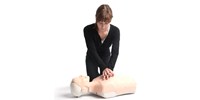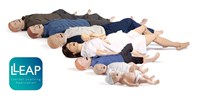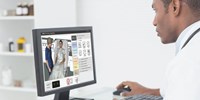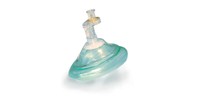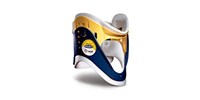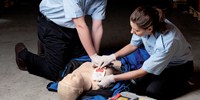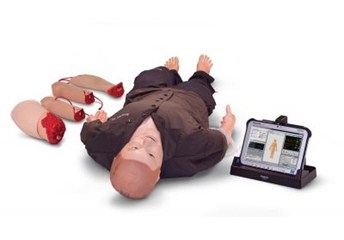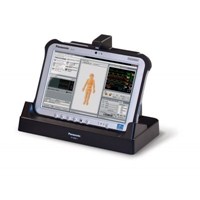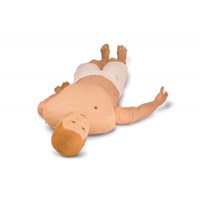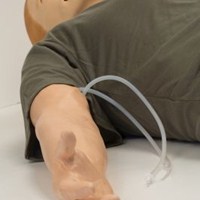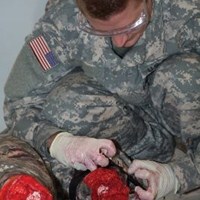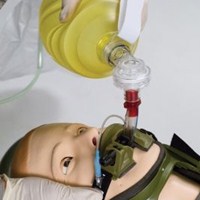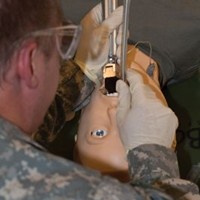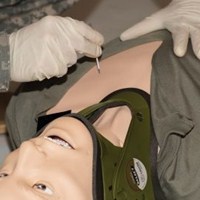|
Multiple Airway Skills/Features:
|
Controllable open/closed airway; automatically or manually controlled
Head tilt/Chin lift
Jaw thrust w/articulated jaw
Suctioning (Oral and Nasopharyngeal)
Bag-mask ventilation
Orotracheal intubation
Nasotracheal intubation
Right main stem intubation
Combitube, LMA, and other airway placement
Retrograde intubation
Fiberoptic intubation
Transtracheal jet ventilation
Needle cricothyrotomy
Surgical cricothyrotomy
Variable lung compliance – 4 settings
Variable airway resistance – 4 settings
Stomach distention
|
|
Airway Complications:
|
Detection of proper head position
Can’t intubate/Can’t ventilate
Can ventilate/ Can’t intubate
Tongue edema
Pharyngeal swelling
Laryngospasm
Decreased cervical range of motion
Trismus
|
|
Breathing Features:
|
Spontaneous breathing
Bilateral and unilateral chest rise and fall
CO2 exhalation
EtCO2 and waveform display
Normal and abnormal breath sounds
- 5 anterior auscultation sites
- 6 posterior auscultation sites
Oxygen saturation and waveform display
|
|
Breathing Complications:
|
Cyanosis
Needle thoracentesis – bilateral
Unilateral and bilateral chest movement
Unilateral, bilateral and lobar breath sounds
Chest tube insertion – bilateral
|
|
Cardiac Features
|
Extensive ECG library
Heart sounds – 4 anterior locations
Simulated ECG rhythm monitoring (4 lead)
ECG Monitoring 3 and 5 lead
12 lead ECG display
Defibrillation and cardioversion
Pacing
|
|
Circulation features:
|
BP measured manually by auscultation of Korotkoff sounds
Carotid, femoral, brachial, radial, dorsalis pedis, popliteal and posterior tibialis pulses synchronized with ECG
Pulse strength variable with BP
Pulse palpation is detected and logged
|
|
Vascular access:
|
IV access (right arm)
Intraosseous access (tibia and sternum)
|
|
CPR:
|
Compliant with 2010 Guidelines
CPR compressions generate palpable pulses, blood pressure waveform, and ECG artifacts
Realistic compression depth and resistance
Detection of depth and frequency of compressions
Detection of leaning
Real-time feedback on quality of CPR
|
|
Eyes:
|
Blinking - slow, normal, fast and winks
Open, closed and partially open
Pupillary accommodation:
- Synchrony/asynchrony
- Normal and sluggish speed of response
|
|
Other Features:
|
Bleeding
- Simulation of bleeding at multiple sites
- Arterial and venous
- Vital signs automatically respond to blood loss and therapy
- Works with various wound modules and moulage kits
Urine output (variable)
Foley catheterization
Secretions
- Eyes, Ears, Nose, Mouth
- Blood, Mucous, CSF, etc.
Diaphoresis
Bowel sounds – four quadrants
Patient voice
- Pre-recorded sounds
- Custom sounds
- Instructor can simulate patient’s voice wirelessly
Instructor communication
- Multiple instructors communicate using integrated
Voice Over Internet Protocol (VOIP)
|
|
Amputations:
|
Amputated left arm
Amputated left leg
Right leg IM skin
Amputated right arm
Amputated right calf skin
|
|
System Features:
|
Wireless Rugged tablet PC controls simulator remotely
Control multiple manikins from one interface
Control simulations from anywhere on your network
Multiple interfaces can control/observe a single simulation
Instructor Mode
- Precise control “on the fly”
- Design and program custom scenarios
- Create custom events
- Run pre-programmed scenarios
Auto Mode
- Physiological models run pre-programmed simulations
-Unique, simple controls increase/decrease difficulty and pace
Simulation controls:
- Fast forward
- Pause
- Rewind
- Save/Restore
Profile Editor
Future prediction and patient outcome display
Integrated video debriefing
Data logging
Instructor comments
|
|
Patient Monitor:
|
Wireless
Highly configurable
Includes:
- ECG (2 traces)
- SpO2
- CO2
- ABP
- CVP
- PAP
- PCWP
- NIBP
- TOF
-Anesthetic Agent
-pH
-PTC
-ICP
- Cardiac output
- Temperature (core and peripheral)
- Additional and programmable parameters
X-Ray display
12 Lead ECG display
Custom image display
Custom video display
|
|
Certifications:
|
UL
CE
FCC
CSA
HMR
|




 Korea
Korea
